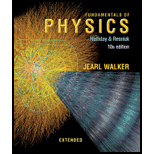
Fundamentals of Physics Extended
10th Edition
ISBN: 9781118230725
Author: David Halliday, Robert Resnick, Jearl Walker
Publisher: Wiley, John & Sons, Incorporated
expand_more
expand_more
format_list_bulleted
Textbook Question
Chapter 14, Problem 18P
In Fig. 14-32, an open tube of length L = 1.8 m and cross-sectional area A = 4.6 cm2 is fixed to the top of a cylindrical barrel of diameter D = 1.2m and height H = 1.8 m. The barrel and tube are filled with water (to the top of the tube). Calculate the ratio of the hydrostatic force on the bottom of the barrel to the gravitational force on the water contained in the barrel. Why is that ratio not equal to 1.0? (You need not consider the atmospheric pressure.)
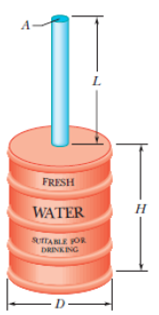
Figure 14-32 Problem 18.
Expert Solution & Answer
Want to see the full answer?
Check out a sample textbook solution
Chapter 14 Solutions
Fundamentals of Physics Extended
Ch. 14 - We fully submerge an irregular 3 kg lump of...Ch. 14 - Figure 14-21 shows four situations in which a red...Ch. 14 - A boat with an anchor on board floats in a...Ch. 14 - Figure 14-22 shows a tank filled with water. Five...Ch. 14 - The teapot effect. Water poured slowly from a...Ch. 14 - Figure 14-24 shows three identical open-top...Ch. 14 - Figure 14-25 shows four arrangements of pipes...Ch. 14 - A rectangular block is pushed face-down into three...Ch. 14 - Water flows smoothly in a horizontal pipe. Figure...Ch. 14 - We have three containers with different Liquids....
Ch. 14 - ILW A fish maintains its depth in fresh water by...Ch. 14 - A partially evacuated airtight container has a...Ch. 14 - SSM Find the pressure increase in the fluid in a...Ch. 14 - Three liquids that will not mix are poured into a...Ch. 14 - SSM An office window has dimensions 3.4 m by 2.1...Ch. 14 - Prob. 6PCh. 14 - In 1654 Otto von Guericke, inventor of the air...Ch. 14 - The bends during flight. Anyone who scuba dives is...Ch. 14 - Blood pressure in Argentinosaurus. a If this...Ch. 14 - The plastic tube in Fig. 14-30 has a...Ch. 14 - Giraffe bending to drink. In a giraffe with its...Ch. 14 - The maximum depth dmax that a diver can snorkel is...Ch. 14 - At a depth of 10.5 km, the Challenger Deep in the...Ch. 14 - Calculate the hydrostatic difference in blood...Ch. 14 - What gauge pressure must a machine produce in...Ch. 14 - Snorkeling by humans and elephants. When a person...Ch. 14 - SSM Crew members attempt to escape from a damaged...Ch. 14 - In Fig. 14-32, an open tube of length L = 1.8 m...Ch. 14 - GO A large aquarium of height 5.00 m is filled...Ch. 14 - The L-shaped fish tank shown in Fig. 14-33 is...Ch. 14 - SSM Two identical cylindrical vessels with their...Ch. 14 - Prob. 22PCh. 14 - GO In analyzing certain geological features, it is...Ch. 14 - GO In Fig. 14-35, water stands at depth D = 35.0 m...Ch. 14 - In one observation, the column in a mercury...Ch. 14 - To suck lemonade of density 1000 kg/m3 up a straw...Ch. 14 - SSM What would be the height of the atmosphere if...Ch. 14 - A piston of cross-sectional area a is used in a...Ch. 14 - In Fig 14-37, a spring of spring constant 3.00 ...Ch. 14 - A 5.00 kg object is released from rest while fully...Ch. 14 - SSM A block of wood floats in fresh water with...Ch. 14 - In Fig. 14-38, a cube of edge length L = 0.600 m...Ch. 14 - SSM An iron anchor of density 7870kg/m3 appears...Ch. 14 - A boat floating in fresh water displaces water...Ch. 14 - Three children, each of weight 356 N, make a log...Ch. 14 - GO In Fig. 14-39a, a rectangular block is...Ch. 14 - ILW A hollow spherical iron shell floats almost...Ch. 14 - GO A small solid ball is released from rest while...Ch. 14 - SSM WWW A hollow sphere of inner radius 8.0 cm and...Ch. 14 - Lurking alligators. An alligator waits for prey by...Ch. 14 - What fraction of the volume of an iceberg density...Ch. 14 - A Flotation device is in the shape of a right...Ch. 14 - When researchers find a reasonably complete fossil...Ch. 14 - A wood block mass 3.67 kg, density 600 kg/m3 is...Ch. 14 - GO An iron casting containing a number of cavities...Ch. 14 - GO Suppose that you release a small ball from rest...Ch. 14 - The volume of air space in the passenger...Ch. 14 - GO Figure 14-44 shows an iron ball suspended by...Ch. 14 - Canal effect. Figure 14-45 shows an anchored barge...Ch. 14 - Figure 14-46 shows two sections of an old pipe...Ch. 14 - SSM A garden hose with an internal diameter of 1.9...Ch. 14 - Two streams merge to form a river. One stream has...Ch. 14 - SSM Water is pumped steadily out of a flooded...Ch. 14 - GO The water flowing through a 1.9 cm inside...Ch. 14 - How much work is done by pressure in forcing 1.4...Ch. 14 - Suppose that two tanks, 1 and 2, each with a large...Ch. 14 - SSM A cylindrical tank with a large diameter is...Ch. 14 - The intake in Fig. 14-47 has cross-sectional area...Ch. 14 - SSM Water is moving with a speed of 5.0 m/s...Ch. 14 - Models of torpedoes are sometimes tested in a...Ch. 14 - ILW A water pipe having a 2.5 cm inside diameter...Ch. 14 - A pitot tube Fig. 14-48 is used to determine the...Ch. 14 - Prob. 63PCh. 14 - GO In Fig. 14-49, water flows through a horizontal...Ch. 14 - SSM WWW A venturi meter is used to measure the...Ch. 14 - Consider the venturi tube of Problem 65 and Fig....Ch. 14 - ILW In Fig. 14-51, the fresh water behind a...Ch. 14 - GO Fresh water flows horizontally from pipe...Ch. 14 - A liquid of density 900 kg/m3 flows through a...Ch. 14 - GO In Fig. 14-53, water flows steadily from the...Ch. 14 - Figure 14-54 shows a stream of water flowing...Ch. 14 - GO A very simplified schematic of the rain...Ch. 14 - About one-third of the body of a person floating...Ch. 14 - A simple open U-tube contains mercury. When 11.2...Ch. 14 - If a bubble in sparkling water accelerates upward...Ch. 14 - Suppose that your body has a uniform density of...Ch. 14 - Prob. 77PCh. 14 - Caught in an avalanche, a skier is fully submerged...Ch. 14 - An object hangs from a spring balance. The balance...Ch. 14 - In an experiment, a rectangular block with height...Ch. 14 - SSM Figure 14-30 shows a modified U-tube: the...Ch. 14 - What is the acceleration of a rising hot-air...Ch. 14 - Figure 14-56 shows a siphon, which is a device for...Ch. 14 - When you cough, you expel air at high speed...Ch. 14 - A tin can has a total volume of 1200 cm3 and a...Ch. 14 - The tension in a string holding a solid block...Ch. 14 - What is the minimum area in square meters of the...Ch. 14 - A 8.60 kg sphere of radius 6.22 cm is at a depth...Ch. 14 - a For seawater of density 1.03 g/cm3, find the...Ch. 14 - The sewage outlet of a house constructed on a...
Additional Science Textbook Solutions
Find more solutions based on key concepts
Can you carry 1m3 of liquid water?
EBK FUNDAMENTALS OF THERMODYNAMICS, ENH
If our solar system is typical, other star systems might have an average of five to ten worlds on which liquid ...
Life in the Universe (4th Edition)
56. Global Positioning System. Learn more about the global positioning system and its uses. Write a short repo...
The Cosmic Perspective (8th Edition)
(a) Beta decay is nuclear decay in which an electron is emitted. If the electron is given 0.750 MeV of kinetic ...
University Physics Volume 3
The angle relative to the x -axis at which the boat must be pointed in order to reach the other dock.
Physics (5th Edition)
Fill in each blank.
36. 1 cm = _____ m
Applied Physics (11th Edition)
Knowledge Booster
Learn more about
Need a deep-dive on the concept behind this application? Look no further. Learn more about this topic, physics and related others by exploring similar questions and additional content below.Similar questions
- Mercury is poured into a U-tube as shown in Figure P15.17a. The left arm of the tube has cross-sectional area A1 of 10.0 cm2, and the right arm has a cross-sectional area A2 of 5.00 cm2. One hundred grams of water are then poured into the right arm as shown in Figure P15.17b. (a) Determine the length of the water column in the right arm of the U-tube. (b) Given that the density of mercury is 13.6 g/cm3, what distance h does the mercury rise in the left arm?arrow_forwardWater enters a smooth, horizontal tube with a speed of 2.0 m/s and emerges out of the tube with a speed of 8.0 m/s. Each end of the tube has a different cross-sectional radius. Find the ratio of the entrance radius to the exit radius.arrow_forwardThe gravitational force exerted on a solid object is 5.00 N. When the object is suspended from a spring scale and submerged in water, the scale reads 3.50 N (Fig. P15.24). Find the density of the object. Figure P15.24 Problems 24 and 25.arrow_forward
- An incompressible, nonviscous fluid is initially at rest in the vertical portion of the pipe shown in Figure P15.61a, where L = 2.00 m. When the valve is opened, the fluid flows into the horizontal section of the pipe. What is the fluids speed when all the fluid is in the horizontal section as shown in Figure P15.61b? Assume the cross-sectional area of the entire pipe is constant. Figure P15.61arrow_forwardBird bones have air pockets to reduce their weight—this also gives them an average density significantly less than that of the bones of other animals. Suppose an ornithologist weighs a bird bone air and in water and finds its mass is 45.0 g ad its apparent mass when submerged is 3.60 g (assume the bone is watertight.)(a) What mass of is displaced? (b) What is the volume of the bone? (c) What is its average density?arrow_forwardIn about 1657, Otto von Guericke, inventor of the air pump, evacuated a sphere made of two brass hemispheres (Fig. P15.62). Two teams of eight horses each could pull the hemispheres apart only on some trials and then with greatest difficulty, with the resulting sound likened to a cannon firing. Find the force F required to pull the thin-walled evacuated hemispheres apart in terms of R, the radius of the hemispheres; P, the pressure inside the hemispheres; and atmospheric pressure P0. Figure P15.62arrow_forward
- Two thin-walled drinking glasses having equal base areas but different shapes, with very different cross-sectional areas above the base, are filled to the same level with water. According to the expression P = P0 + gh, the pressure is the same at the bottom of both glasses. In view of this equality, why does one weigh more than the other?arrow_forwardA spherical weather balloon is filled with hydrogen until its radius is 3.00 m. Its total mass including the instruments it carries is 15.0 kg. (a) Find the buoyant force acting on the balloon, assuming the density of air is 1.29 kg/m3. (b) What is the net force acting on the balloon and its instruments after the balloon is released from the ground? (c) Why does the radius of the balloon tend to increase as it rises to higher altitude?arrow_forwardA U-tube open at both ends is partially filled with water (Fig. P15.67a). Oil having a density 750 kg/m3 is then poured into the right arm and forms a column L = 5.00 cm high (Fig. P15.67b). (a) Determine the difference h in the heights of the two liquid surfaces. (b) The right arm is then shielded from any air motion while air is blown across the top of the left arm until the surfaces of the two liquids are at the same height (Fig. P15.67c). Determine the speed of the air being blown across the left arm. Take the density of air as constant at 1.20 kg/m3.arrow_forward
arrow_back_ios
arrow_forward_ios
Recommended textbooks for you
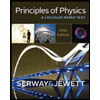 Principles of Physics: A Calculus-Based TextPhysicsISBN:9781133104261Author:Raymond A. Serway, John W. JewettPublisher:Cengage Learning
Principles of Physics: A Calculus-Based TextPhysicsISBN:9781133104261Author:Raymond A. Serway, John W. JewettPublisher:Cengage Learning Physics for Scientists and Engineers: Foundations...PhysicsISBN:9781133939146Author:Katz, Debora M.Publisher:Cengage Learning
Physics for Scientists and Engineers: Foundations...PhysicsISBN:9781133939146Author:Katz, Debora M.Publisher:Cengage Learning College PhysicsPhysicsISBN:9781305952300Author:Raymond A. Serway, Chris VuillePublisher:Cengage Learning
College PhysicsPhysicsISBN:9781305952300Author:Raymond A. Serway, Chris VuillePublisher:Cengage Learning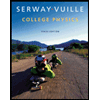 College PhysicsPhysicsISBN:9781285737027Author:Raymond A. Serway, Chris VuillePublisher:Cengage Learning
College PhysicsPhysicsISBN:9781285737027Author:Raymond A. Serway, Chris VuillePublisher:Cengage Learning Physics for Scientists and Engineers, Technology ...PhysicsISBN:9781305116399Author:Raymond A. Serway, John W. JewettPublisher:Cengage Learning
Physics for Scientists and Engineers, Technology ...PhysicsISBN:9781305116399Author:Raymond A. Serway, John W. JewettPublisher:Cengage Learning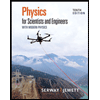 Physics for Scientists and Engineers with Modern ...PhysicsISBN:9781337553292Author:Raymond A. Serway, John W. JewettPublisher:Cengage Learning
Physics for Scientists and Engineers with Modern ...PhysicsISBN:9781337553292Author:Raymond A. Serway, John W. JewettPublisher:Cengage Learning

Principles of Physics: A Calculus-Based Text
Physics
ISBN:9781133104261
Author:Raymond A. Serway, John W. Jewett
Publisher:Cengage Learning

Physics for Scientists and Engineers: Foundations...
Physics
ISBN:9781133939146
Author:Katz, Debora M.
Publisher:Cengage Learning

College Physics
Physics
ISBN:9781305952300
Author:Raymond A. Serway, Chris Vuille
Publisher:Cengage Learning

College Physics
Physics
ISBN:9781285737027
Author:Raymond A. Serway, Chris Vuille
Publisher:Cengage Learning

Physics for Scientists and Engineers, Technology ...
Physics
ISBN:9781305116399
Author:Raymond A. Serway, John W. Jewett
Publisher:Cengage Learning

Physics for Scientists and Engineers with Modern ...
Physics
ISBN:9781337553292
Author:Raymond A. Serway, John W. Jewett
Publisher:Cengage Learning
How to Calculate Density of Liquids - With Examples; Author: cleanairfilms;https://www.youtube.com/watch?v=DVQMWihs3wQ;License: Standard YouTube License, CC-BY